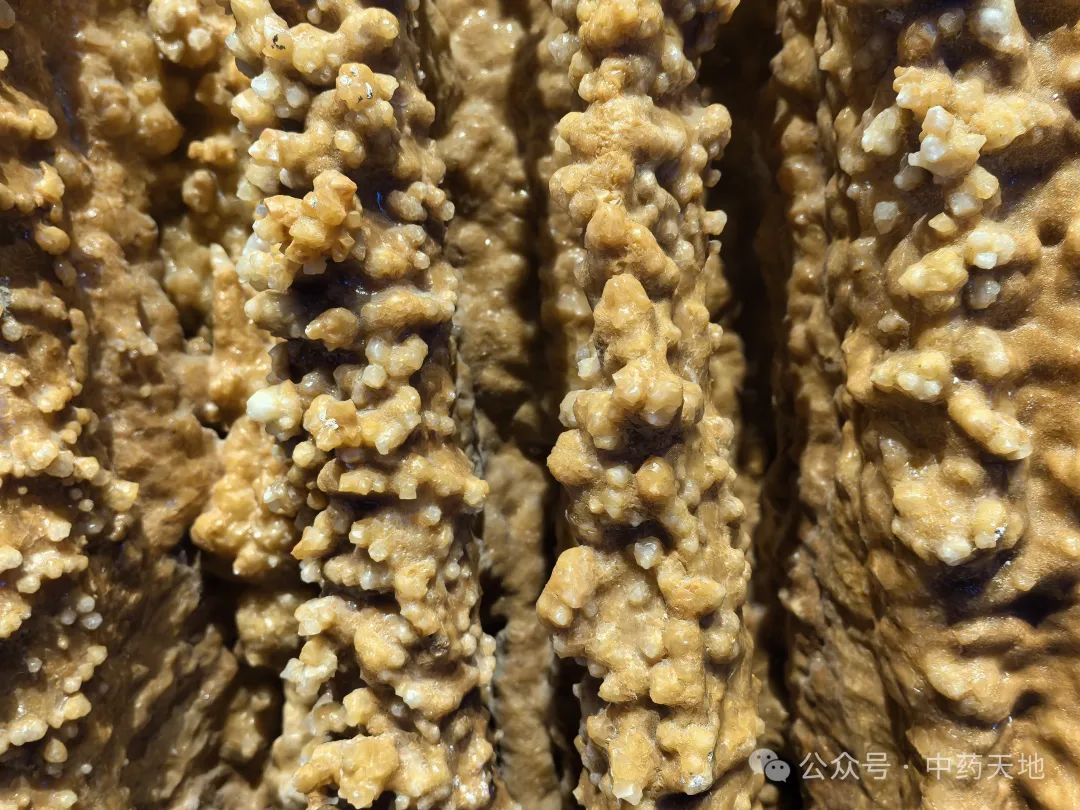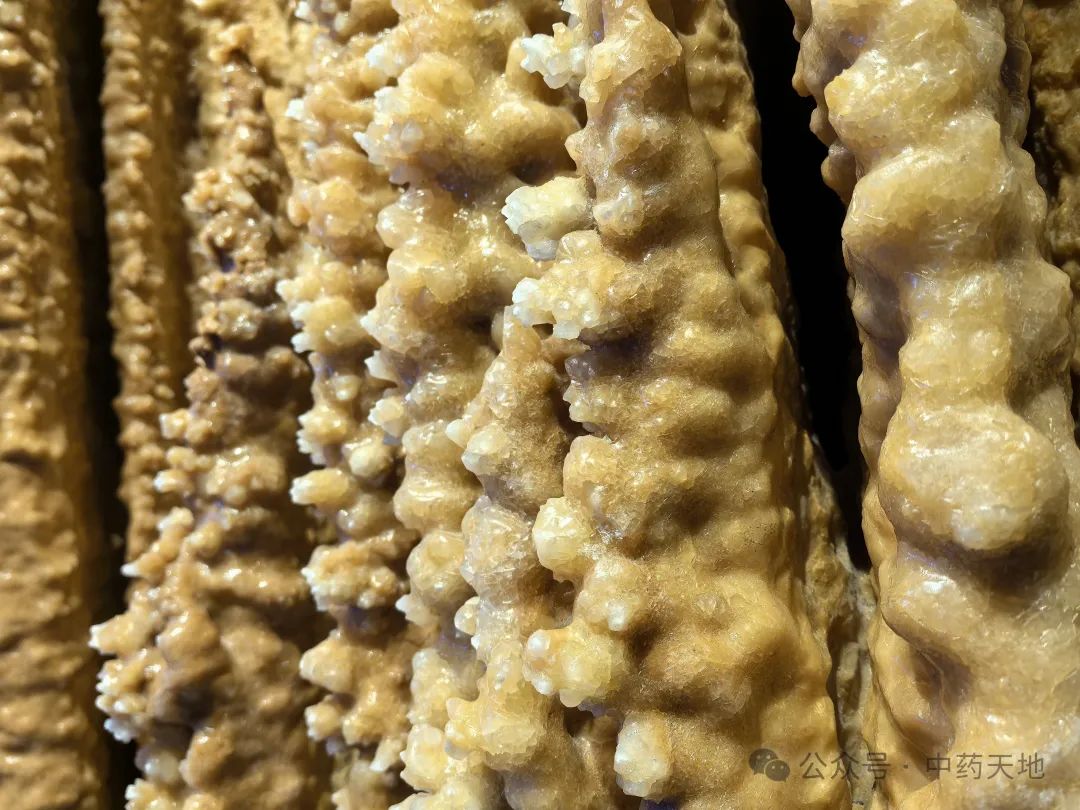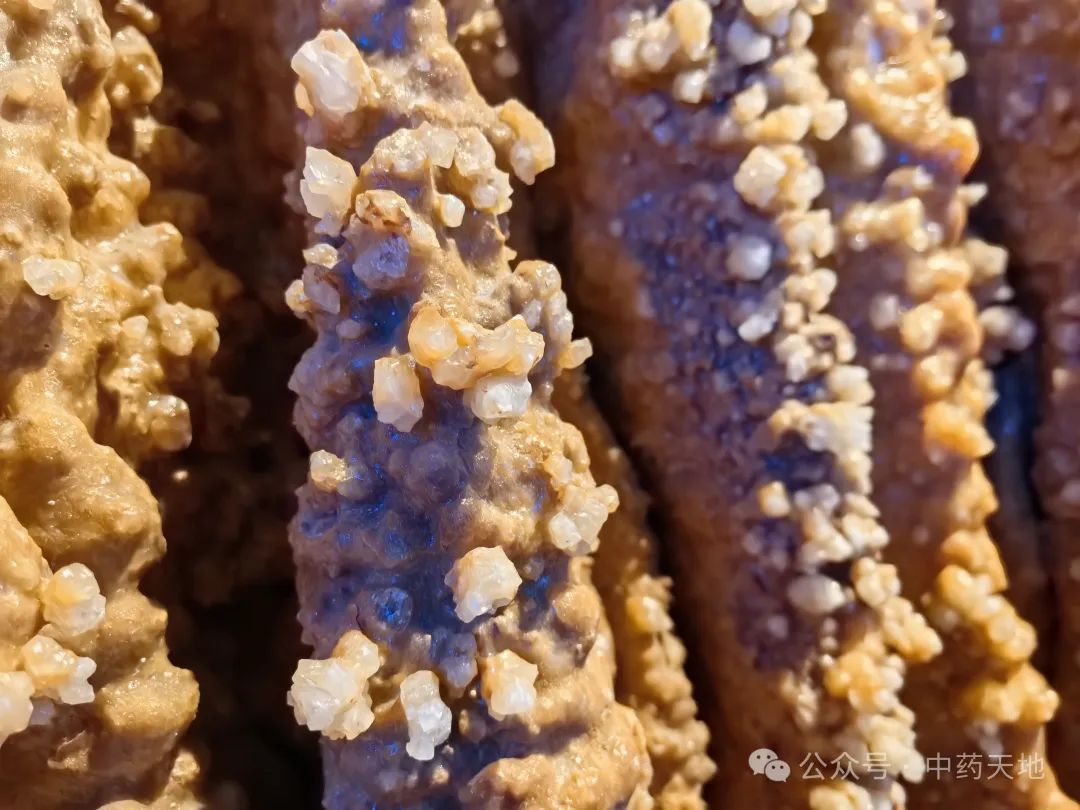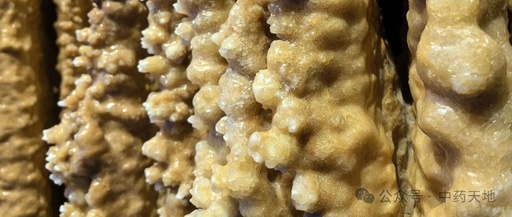The “Traditional Chinese Medicine Images” section features recent photographs taken and compiled by the editor. Please leave your comments and suggestions at the end! We hope for your shares and likes, thank you! For photo requests, please contact the editor. Unauthorized reproduction is prohibited.
Stalactite
 (Photographed at the Geological Museum of Guizhou Province)Source of Medicinal Materialis a carbonate mineral from the calcite family, primarily composed of calcium carbonate (CaCO3). Coarse stalactites are referred to as “zhongru”; fine tubular formations are called “dilushi”.Harvesting and Processingcan be done at any time. After harvesting, remove impurities, wash, and dry.Preparation MethodStalactite: Wash with water and crush into small pieces. Calcined Stalactite: Take clean stalactite, place it in a crucible, calcine until red, remove and cool, then grind finely.Alias includes Shizhongru, Xuzhong, Zhongru, Gongru, Liugongru, Lushi, Xiashi, Huangshisha, Lubu, and Xirugu.Properties and ChannelsSweet in flavor, warm in nature; enters the Lung, Kidney, and Stomach channels.Functions and IndicationsWarms the lungs, assists yang, relieves wheezing, neutralizes acidity, promotes lactation. Indicated for cold phlegm cough and wheezing, yang deficiency with cold wheezing, impotence, cold pain in the lower back and knees, stomach pain with acid reflux, poor appetite due to food stagnation, insufficient lactation, and sores or hemorrhoids.
(Photographed at the Geological Museum of Guizhou Province)Source of Medicinal Materialis a carbonate mineral from the calcite family, primarily composed of calcium carbonate (CaCO3). Coarse stalactites are referred to as “zhongru”; fine tubular formations are called “dilushi”.Harvesting and Processingcan be done at any time. After harvesting, remove impurities, wash, and dry.Preparation MethodStalactite: Wash with water and crush into small pieces. Calcined Stalactite: Take clean stalactite, place it in a crucible, calcine until red, remove and cool, then grind finely.Alias includes Shizhongru, Xuzhong, Zhongru, Gongru, Liugongru, Lushi, Xiashi, Huangshisha, Lubu, and Xirugu.Properties and ChannelsSweet in flavor, warm in nature; enters the Lung, Kidney, and Stomach channels.Functions and IndicationsWarms the lungs, assists yang, relieves wheezing, neutralizes acidity, promotes lactation. Indicated for cold phlegm cough and wheezing, yang deficiency with cold wheezing, impotence, cold pain in the lower back and knees, stomach pain with acid reflux, poor appetite due to food stagnation, insufficient lactation, and sores or hemorrhoids. DosageInternal use: Decoction, 9-15 grams; or in pills or powders.PrecautionsContraindicated for those with yin deficiency and excess heat causing lung cough.Characteristics of the Medicinal MaterialStalactite is a stalactitic aggregate, slightly conical or cylindrical in shape. The surface is white, grayish-white, or brownish-yellow, rough, and uneven. It is heavy, hard, with a relatively flat fracture surface, white to light gray, exhibiting a star-like luster when viewed in light, often with a round hole at the center surrounded by many shallow orange-yellow concentric rings. Odorless, with a slightly salty taste. Dilushiis tubular or cylindrical, hollow, slightly curved, 3-5 cm long; diameter 1-1.5 cm, wall thickness about 1 mm. The surface is milky white or grayish-yellow, mostly translucent, rough or slightly smooth. Hard and brittle, easily broken, with a glassy luster on the fracture surface, larger hollow spaces, and some visible concentric layers. Odorless, with a slightly salty taste.The best quality is white or grayish-white, round, with a star-like luster on the fracture surface.
DosageInternal use: Decoction, 9-15 grams; or in pills or powders.PrecautionsContraindicated for those with yin deficiency and excess heat causing lung cough.Characteristics of the Medicinal MaterialStalactite is a stalactitic aggregate, slightly conical or cylindrical in shape. The surface is white, grayish-white, or brownish-yellow, rough, and uneven. It is heavy, hard, with a relatively flat fracture surface, white to light gray, exhibiting a star-like luster when viewed in light, often with a round hole at the center surrounded by many shallow orange-yellow concentric rings. Odorless, with a slightly salty taste. Dilushiis tubular or cylindrical, hollow, slightly curved, 3-5 cm long; diameter 1-1.5 cm, wall thickness about 1 mm. The surface is milky white or grayish-yellow, mostly translucent, rough or slightly smooth. Hard and brittle, easily broken, with a glassy luster on the fracture surface, larger hollow spaces, and some visible concentric layers. Odorless, with a slightly salty taste.The best quality is white or grayish-white, round, with a star-like luster on the fracture surface. Mineral Formis a stalactitic aggregate of the calcite family (see “Calcite” entry), appearing in cylindrical or conical shapes. Commonly found in limestone caves. Formed from calcium carbonate solutions dripping through rock fissures, accumulating as water evaporates and carbon dioxide escapes, gradually growing downwards from the cave ceiling. The crystal structure belongs to the trigonal system. It appears in flattened conical, conical, and cylindrical shapes. The surface is rough and uneven. Generally white, some may be grayish-white or light brownish-white due to impurities. Glassy or dull luster. Hardness of 3, brittle. The fracture surface is relatively flat, showing concentric layered structures with radial formations, some with hollows at the center. Relative density is 2.6-2.8.Habitat DistributionStalactites are formed from calcium carbonate solutions dripping through limestone fissures, accumulating as water evaporates and carbon dioxide escapes, gradually growing downwards from the cave ceiling. They are distributed in Shanxi, Shaanxi, Gansu, Hubei, Hunan, Guangdong, Guangxi, Sichuan, Guizhou, Yunnan, and other regions.Classic Formulas and Recipes1. Zhongru Pill (from “Shengji Zonglu”)Treats lung deficiency with obstructive wheezing: 250 grams of fresh stalactite (finely ground to powder), 150 grams of yellow wax (shredded). Mix the two ingredients, first melting the yellow wax in a fine porcelain container over low heat, then adding the stalactite powder, stirring until uniform. Remove, seal, and steam in a rice steamer until cooked, then grind into a paste and form into pills the size of a Chinese parasol seed. Take 1-2 pills with warm water.
Mineral Formis a stalactitic aggregate of the calcite family (see “Calcite” entry), appearing in cylindrical or conical shapes. Commonly found in limestone caves. Formed from calcium carbonate solutions dripping through rock fissures, accumulating as water evaporates and carbon dioxide escapes, gradually growing downwards from the cave ceiling. The crystal structure belongs to the trigonal system. It appears in flattened conical, conical, and cylindrical shapes. The surface is rough and uneven. Generally white, some may be grayish-white or light brownish-white due to impurities. Glassy or dull luster. Hardness of 3, brittle. The fracture surface is relatively flat, showing concentric layered structures with radial formations, some with hollows at the center. Relative density is 2.6-2.8.Habitat DistributionStalactites are formed from calcium carbonate solutions dripping through limestone fissures, accumulating as water evaporates and carbon dioxide escapes, gradually growing downwards from the cave ceiling. They are distributed in Shanxi, Shaanxi, Gansu, Hubei, Hunan, Guangdong, Guangxi, Sichuan, Guizhou, Yunnan, and other regions.Classic Formulas and Recipes1. Zhongru Pill (from “Shengji Zonglu”)Treats lung deficiency with obstructive wheezing: 250 grams of fresh stalactite (finely ground to powder), 150 grams of yellow wax (shredded). Mix the two ingredients, first melting the yellow wax in a fine porcelain container over low heat, then adding the stalactite powder, stirring until uniform. Remove, seal, and steam in a rice steamer until cooked, then grind into a paste and form into pills the size of a Chinese parasol seed. Take 1-2 pills with warm water. 2. Grass Stalactite Pill (from “Qianjin Yifang”)Treats five labors and seven injuries, lung qi deficiency, extreme cold in hands and feet, palpitations, marrow deficiency with lower back pain and leg numbness, restlessness, dry mouth with inability to eat: 100 grams of stalactite (finely ground), 50 grams of dodder seed (soaked in wine overnight, then crushed), 50 grams of dendrobium, 25 grams of evodia. Mix the four ingredients, crush and sift into powder, form into pills with honey the size of a walnut. Take seven pills on an empty stomach, repeat twice daily, walk a few hundred steps, drink three cups of warm clear wine, walk another two or three hundred steps, if there is heat in the mouth and chest, eat dry rice with bean paste; after one day, eat as usual, and warm will be restored.3. Milk Decoction of Stalactite (from “Cui’s Compendium”)Treats accumulation of cold and upward qi, inability to sit or lie down, and wind deficiency: 150 grams of stalactite, ground to flour, placed in a cloth bag, tied loosely, and boiled in one liter of cow’s milk, reduce to one-third, then drink the milk. If the patient is cold, steam with wine; if the patient is hot, boil with water. If using water or wine, reduce by half. Avoid hot noodles, pork, fish, garlic, etc.4. Stalactite Wine (from “Qianjin Fang”)Treats deficiency, promotes blood circulation, and greatly tonifies qi: 250 grams of stalactite, 100 grams each of aconite and sweet chrysanthemum, 250 grams each of dendrobium and cistanche. Mix the five ingredients and soak in three liters of clear wine. Take 200 ml, twice daily, gradually increasing to 1 liter.Modern ResearchStalactite primarily contains calcium carbonate, along with trace elements such as Fe, Cu, Na, K, Mn, Cr, Mg, and Si, as well as rare earth elements like La, Ce, Nd, Sm, Eu, Tb, Yb, and Lu. Clinically, it is used to treat various types of asthma, digestive ulcers, metrorrhagia, cervical erosion, impotence, bedsores, chapped skin, neonatal red buttocks, tumors, rheumatoid arthritis, and sports injuries.This content is mainly referenced from the “Chinese Pharmacopoeia” and “Flora of China” and is for educational exchange only. Please follow medical advice for medication.
2. Grass Stalactite Pill (from “Qianjin Yifang”)Treats five labors and seven injuries, lung qi deficiency, extreme cold in hands and feet, palpitations, marrow deficiency with lower back pain and leg numbness, restlessness, dry mouth with inability to eat: 100 grams of stalactite (finely ground), 50 grams of dodder seed (soaked in wine overnight, then crushed), 50 grams of dendrobium, 25 grams of evodia. Mix the four ingredients, crush and sift into powder, form into pills with honey the size of a walnut. Take seven pills on an empty stomach, repeat twice daily, walk a few hundred steps, drink three cups of warm clear wine, walk another two or three hundred steps, if there is heat in the mouth and chest, eat dry rice with bean paste; after one day, eat as usual, and warm will be restored.3. Milk Decoction of Stalactite (from “Cui’s Compendium”)Treats accumulation of cold and upward qi, inability to sit or lie down, and wind deficiency: 150 grams of stalactite, ground to flour, placed in a cloth bag, tied loosely, and boiled in one liter of cow’s milk, reduce to one-third, then drink the milk. If the patient is cold, steam with wine; if the patient is hot, boil with water. If using water or wine, reduce by half. Avoid hot noodles, pork, fish, garlic, etc.4. Stalactite Wine (from “Qianjin Fang”)Treats deficiency, promotes blood circulation, and greatly tonifies qi: 250 grams of stalactite, 100 grams each of aconite and sweet chrysanthemum, 250 grams each of dendrobium and cistanche. Mix the five ingredients and soak in three liters of clear wine. Take 200 ml, twice daily, gradually increasing to 1 liter.Modern ResearchStalactite primarily contains calcium carbonate, along with trace elements such as Fe, Cu, Na, K, Mn, Cr, Mg, and Si, as well as rare earth elements like La, Ce, Nd, Sm, Eu, Tb, Yb, and Lu. Clinically, it is used to treat various types of asthma, digestive ulcers, metrorrhagia, cervical erosion, impotence, bedsores, chapped skin, neonatal red buttocks, tumors, rheumatoid arthritis, and sports injuries.This content is mainly referenced from the “Chinese Pharmacopoeia” and “Flora of China” and is for educational exchange only. Please follow medical advice for medication.
The editor’s level is limited, and there may be errors in the images and text. Comments and discussions are welcome.
The images are taken by the editor; please contact for use.
This account is dedicated to the dissemination of TCM cultural knowledge. Articles can be reproduced, but please indicate the source, as collecting and organizing requires time. Thank you for your understanding!

